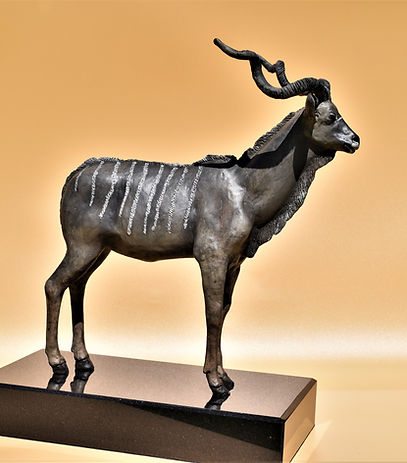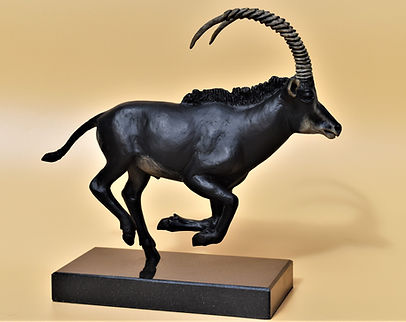HORNS OF AFRICA
This collection features African species with spectacular horns. The collection includes the white rhino, Cape buffalo, greater kudu, sable antelope and gemsbok.
White Rhino
"Crash"
The white rhino is the second largest largest land mammal. There are two subspecies, the northern and southern subspecies. The northern subspecies is functionally extinct with only 2 females surviving. The southern subspecies is classified as Near Threatened. A group of rhinos is known as a "crash" . The term also describes what has happened to their population numbers.
14.5 in L, 4.25 in W, 7 in H
base 12 in L, 6 in W, 1.5 in H


Cape Buffalo
"Boss"
The cape buffalo is widespread across the savannahs of sub-Saharan Africa. It's the only member of the buffalo and cattle tribe found in Africa. The solid shield of horn that covers the male cape buffalo's head is called the "boss". They are fierce and have been known to attack even the king of beasts, the lion.
13.5 in L, 3.5 in W, 8 in H
base 12 in L, 6 in W, 1.5 in H


Greater Kudu
"Vigilant"
The greater kudu is most common in southern Africa but smaller populations can be found in East Africa, the horn of Africa and southern Sahara. They prefer lightly wooded savanna and rocky bush country. The long horns generally have two and half twists and occasionally 3 full twists. They are highly alert and notoriously hard to approach. When they detect danger they give an alarm bark and flee quickly. Kudus are classified as "near threatened". Threats to their existence include habitat loss and hunting.
12 in L, 5.5 in W, 12.75 in H
base 12 in L, 6 in W, 2 in H


Gemsbok
"Nomad"
The gemsbok is the best know of four species of oryx. They are found in the deserts, scrublands and brushlands of southwestern Africa. They live in herds of 10 to 40 animals and are highly nomadic in the desert. They weigh around 200 to 250 kg. Both males and females have horns that extend up to 33 inches. They live in harsh habitats that typically have very little water. They obtain moisture from tsama melons and digging up tubers, roots and plant bulbs.
12 in L, 2.5 in W, 11.75 in H
base - 12 in L, 6 in W, 2 in H


Sable Antelope-
"Revered"
Sable antelope live in the southern savannas of Africa. They prefer a combination of grassland and woodland and tend to avoid vast open lands. Bothe sexes have impressive ringed horns that curve backwards. Socially they usually live in small herds of females led by a territorial male. They eat mostly grass and occasionally herbs and small leaves from shrubs. The local tribes consider it to be a sacred animal and as such it is revered as a beast of the gods.
11.5 in L, 2 in W, 9.5 in H
base - 8 in L, 4 in W, 1 in H

